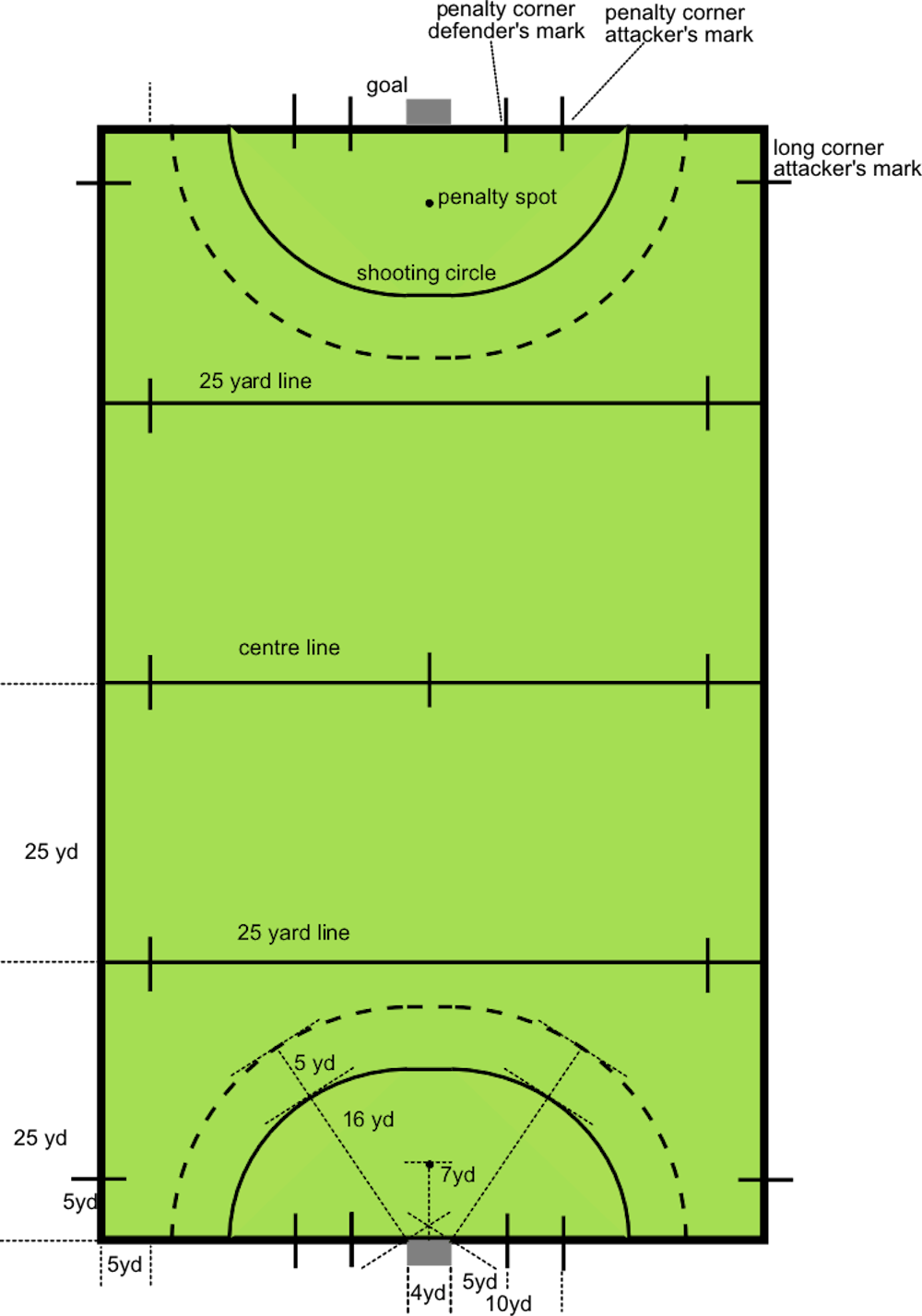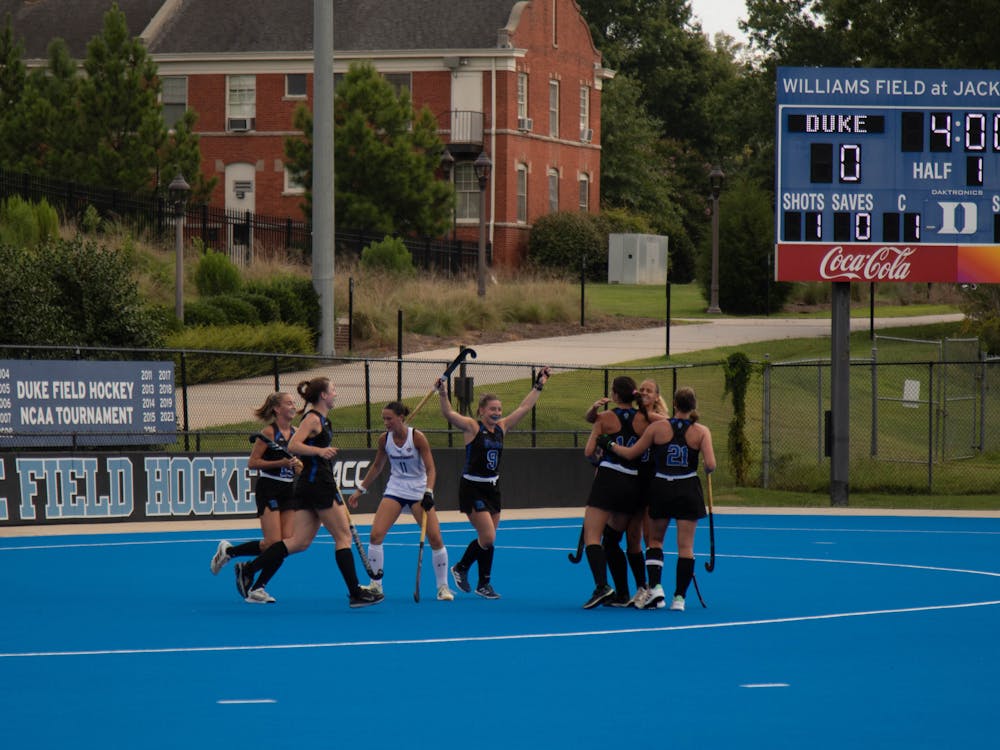With the fall sports season underway, The Chronicle is here with a breakdown of every sport, including key rules, terminology, tournament formats and more. First up is field hockey:
Overview
The game is split up into four 15-minute quarters and features an 11 vs. 11 matchup on a field smaller than a soccer field. Players use a field hockey stick to dribble with the ultimate objective of scoring on the opposing team’s goal. Field hockey sticks feature a rounded and flat side; players must dribble with the flat side of the stick, and all sticks are right handed.

Terminology
Positions
- Forward: The forwards are the most offensive-minded players on the field and do most of the scoring for the team. Forwards can be wings — working up and down the sidelines — or they can be center forwards.
- Midfielders: Midfielders cover the most ground in a match, being utilized on both the offensive and defensive ends of the turf.
- Defenders: Defenders primarily reside in the defensive half; they protect the goalie and prevent forwards from gaining quality opportunities on net. Their greatest contribution comes on corners, where they stand in the goal to help the goalie.
- Sweeper: The use of the sweeper is dependent on the formation of the team and if a team wants to play more defensive. The sweeper is positioned between the defenders and goalkeeper and acts as an extra defender to support the backline.
- Goalkeeper: The goalkeeper’s purpose is to protect the goal within the shooting circle. Goalkeepers are the only players who can touch the ball with any part of their body, but must only do so in the shooting circle.
The shooting circle: Also called ‘The D’ for short, this semicircle is on either end of the field. The ball has to be touched inside the circle for a goal to count; this will usually be a shot from inside the circle or often a shot from outside the circle that is tipped inside the circle.
Center pass: At the start of each half or after a goal has been scored, the play starts with a pass at center field.
End line: The end lines are the two out-of-bound lines that run across opposing shorter sides of the field. A ball that crosses the end line may result in a penalty corner, a self pass or hit at the 16-yard line by the defense, or a long corner for the offense.
Center line: The center line is the line that extends across center field from sideline to sideline.
Penalty corner: A penalty corner occurs when there is a defensive foul inside the circle, this is the offense's best chance at scoring.
Penalties
Obstruction: Obstructions account for many of the penalties in field hockey matches that result in a free hit for the opposing team. Below are a few examples of obstructions.
- A player backs into an opponent or defender.
- A player shields the ball from an opponent with their stick or body, as well as a legitimate tackle.
- A player uses the stick to prevent their opponent from playing the ball.
Penalty corner: A penalty corner occurs due to the defensive team intentionally passing the ball over the end line or if a foul occurs in the shooting circle. In the event of a penalty corner, four defenders and the goalkeeper start behind the backline while the rest of the team starts behind the center line.
One attacking player takes a shot from hash on the end line while the rest of the attack starts on the edge of the shooting circle. The inserter passes the ball to one of the forwards on the edge of the circle who must first bring the ball out of the circle before putting it back in. If the attacking player shoots the ball, the height it reaches must be no higher than the height of the board in the goal. The inserter cannot touch the ball after the insert until another player on the team has touched it.
Get The Chronicle straight to your inbox
Sign up for our weekly newsletter. Cancel at any time.
Penalty stroke: If an intentional foul occurs in the attacking circle, a player on the offensive team is awarded a single shot against the goalkeeper from the penalty spot. A penalty stroke is awarded if the foul prevents a goal from being scored. For example, an automatic penalty stroke would arise if a defender stopped the ball on the goalline with their foot.
Charging: A charging foul is when a player takes excessive movement to bodycheck a player on the opposing team with the purpose of hurting the opponent and not going for the ball.
Raised ball: A foul can be called if a player raises the ball with their stick above knee height while an opponent is in close proximity, and if the hit is not an attempt on goal.
High stick: A high-stick penalty occurs when a player hits an opponent with their stick at a height above shoulder level.
Hacking: An interference foul where the player hits the opposing player’s stick instead of the ball.
Additional rules
Cards: Umpires can give out three kinds of cards to a player that has committed a serious foul: green, yellow and red. Green cards are the least severe and are usually awarded when there is a delay of game or substitution error. Yellow and red cards are given for more dangerous plays.
- If a player receives a green card, they cannot play for two minutes.
- If a player receives a yellow card, they are suspended for a minimum of five minutes.
- If a player receives a red card, they are suspended for the rest of the game.
Substitutions: Substitutions can occur at any time and teams are awarded unlimited substitutions. Players must come off the field before the substitute enters the game or else the transition can result in a card. Additionally, players must leave and enter the field within three meters of the center line. Substitutions cannot occur during a corner and instead players must wait until the ball is inserted.
Season format
There are currently 79 Division I field hockey teams, and nine of these teams reside in the ACC, including the two new additions in Stanford and Cal. During the regular season, the Blue Devils will play a total of 16 games — eight of these coming against conference opponents.
ACC tournament: The ACC tournament features the top eight teams at the end of the regular season. The tournament includes a quarterfinal, semifinals and final that occur Nov. 5-8.
NCAA tournament: The 2023 NCAA tournament featured 18 teams, ten of these teams earning automatic qualification for winning their conference tournament and representing their conferences. The tournament includes two play-in games, featuring the four lowest automatic-qualification teams. The tournament takes place in mid November shortly after the conference tournaments.
Coaching staff and recent trends
The field hockey team is led by head coach Pam Bustin, who enters her 13th season with the Blue Devils. Bustin has had a few ups and downs during her time as head coach, but she became the winningest coach in program history this season. The 2022 season particularly reflects her struggles as the team went 0-6 in conference play. However, the 2023 squad was a powerhouse in the ACC, going 5-1 with its only loss coming against North Carolina. Duke fell again to its rival down the road in the ACC Championship, and after an impressive run in the NCAA tournament, lost to No. 2 Northwestern in the Final Four. With players like Alaina McVeigh, Paige Bitting and Charlie van Oirschot all returning for another season, the Blue Devils have the opportunity to do something special.
Click here for The Chronicle's beginner's guide to every sport.

